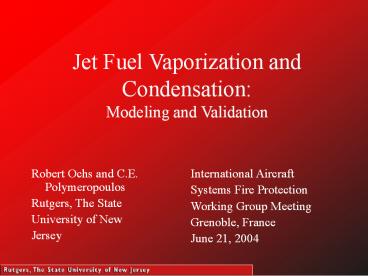Jet Fuel Vaporization and Condensation: Modeling and Validation - PowerPoint PPT Presentation
Title:
Jet Fuel Vaporization and Condensation: Modeling and Validation
Description:
Jet Fuel Vaporization and Condensation: Modeling and Validation Robert Ochs and C.E. Polymeropoulos Rutgers, The State University of New Jersey International Aircraft – PowerPoint PPT presentation
Number of Views:117
Avg rating:3.0/5.0
Title: Jet Fuel Vaporization and Condensation: Modeling and Validation
1
Jet Fuel Vaporization and Condensation Modeling
and Validation
- Robert Ochs and C.E. Polymeropoulos
- Rutgers, The State
- University of New
- Jersey
- International Aircraft
- Systems Fire Protection
- Working Group Meeting
- Grenoble, France
- June 21, 2004
2
Part I Physical Considerations and Modeling
3
Motivation
- Combustible mixtures can be generated in the
ullage of aircraft fuel tanks - Need for estimating temporal dependence of F/A
on - Fuel Loading
- Temperature of the liquid fuel and tank walls
- Ambient pressure and temperature
4
Physical Considerations
- 3D natural convection heat and mass transfer
- Liquid vaporization
- Vapor condensation
- Variable Pa and Ta
- Multicomponent vaporization and condensation
- Well mixed liquid and gas phases
- Rayleigh number of liquid o(106)
- Rayleigh number of ullage o(109)
5
Principal Assumptions
- Well mixed gas and liquid phases
- Uniformity of temperatures and species
concentrations in the ullage and in the
evaporating liquid fuel pool - Use of available experimental liquid fuel and
tank wall temperatures - Quasi-steady transport using heat transfer
correlations and the analogy between heat and
mass transfer for estimating film coefficients
for heat and mass transfer - Liquid Jet A composition from published data from
samples with similar flash points as those tested
6
Heat and Mass Transport
- Liquid Surfaces (species evaporation/condensation)
- Fuel species mass balance
- Henrys law (liquid/vapor equilibrium)
- Wagners equation (species vapor pressures)
- Ullage Control Volume (variable pressure and
temperature) - Fuel species mass balance
- Overall mass balance (outflow/inflow)
- Overall energy balance
- Natural convection enclosure heat transfer
correlations - Heat and mass transfer analogy for the mass
transfer coefficients
7
Liquid Jet A Composition
- Liquid Jet A composition depends on origin and
weathering - Jet A samples with different flash points were
characterized by Woodrow (2003) - Results in terms of C5-C20 Alkanes
- Computed vapor pressures in agreement with
measured data - JP8 used with FAA testing in the range of 115-125
Deg. F. - Present results use compositions corresponding to
samples with F.P.120 Deg. F. and 125 Deg. F.
from the Woodrow (2003) data
8
Composition of the Fuels Usedfrom Woodrow (2003)
9
Dry Tank Tests
- Tests run without fuel in the tank to check the
accuracy of the heat transfer correlations
without the added variable of mass transfer - Ullage temperature was measured in three
different locations to verify the well-mixed
assumption - The measured ullage temperature was compared with
the calculated ullage temperature
10
Dry Tank Ullage TemperatureComparison of
measured vs. calculated ullage temperatureShows
validity of well-mixed ullage assumption
Measured ullage temp
Calculated ullage temp
11
Part II Experimental Validation of Modeling
12
Overview
- Fuel vaporization experimentation is performed at
W.J.H. Technical Center at Atlantic City Airport,
NJ - Experimental data consists of hydrocarbon
concentrations and temperatures as functions of
time - Data is input into computer model and compared to
calculated vapor composition
13
Model Inputs
- Fuel and tank surface temperature profiles
- Pressure and outside air temperatures as
functions time - Fuel composition (volume fractions of C5-C20
Alkanes) from Woodrow (2003) - Tank dimensions and fuel loading
14
Model Outputs
- Hydrocarbon concentration profile
- Propane equivalent hydrocarbon concentrations
- Parts per million or percent propane can be
converted into F/A ratio - Ullage temperature profile
15
Experimental Setup
- Fuel tank 36x36x24, ¼ thick aluminum
- Sample ports
- Heated hydrocarbon sample line
- Pressurization of the sample for sub-atmospheric
pressure experiments - Intermittent (10 minute intervals) 30 sec long
sampling - FID hydrocarbon analyzer, cal. w/2 propane,
check w/4 - 12 thermocouples
- Blanket heater for uniform floor heating
- Unheated walls and ceiling
- JP-8 Fuel
16
Experimental Setup (continued)
- Fuel tank inside environmental chamber
- Programmable variation of chamber pressure and
temperature using - Vacuum pump system
- Air heating and refrigeration system
17
Experimental Setup (continued)
18
Thermocouple Locations
19
Experimental Procedure
- Fill tank with specified quantity of fuel
- Adjust chamber pressure and temperature to
desired values, let equilibrate for 1-2 hours - Begin to record data with DAS
- Take initial hydrocarbon reading to get initial
quasi-equilibrium fuel vapor concentration - Set tank pressure and temperature as well as the
temperature variation - Experiment concludes when hydrocarbon
concentration levels off and quasi-equilibrium is
attained
20
Experimental Results
21
Experimental Results
22
Experimental Results
23
Flight Profile Tests
24
Simulated Flight
25
Pure Component Fuel
- Use isooctane (C8H18) as test fuel
- Pure component removes the ambiguity of
multi-component fuel composition - Highly volatile at room temperature need to
cool fuel to approx 0 deg. F. to stay within
range of hydrocarbon analyzer
26
Isooctane
27
Conclusions and Future Work
- Measure flammability with NDIR type hydrocarbon
analyzer and compare results with FID type
analyzer - Use experimental data from flight tests to
compare measured with calculated flammability - Simulate flight test scenarios in the lab to
compare flammability of flight tests, lab tests,
and calculated results






























